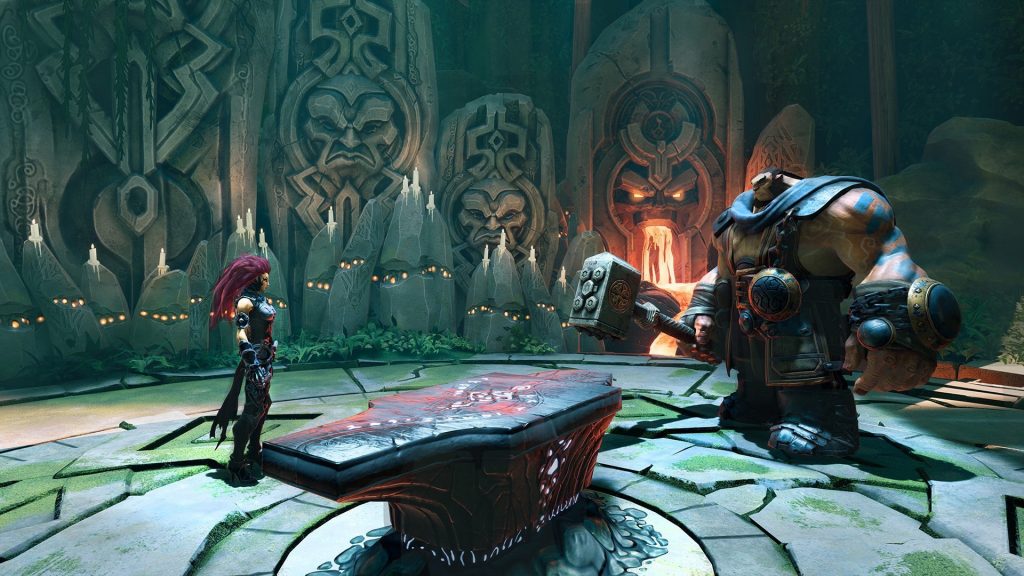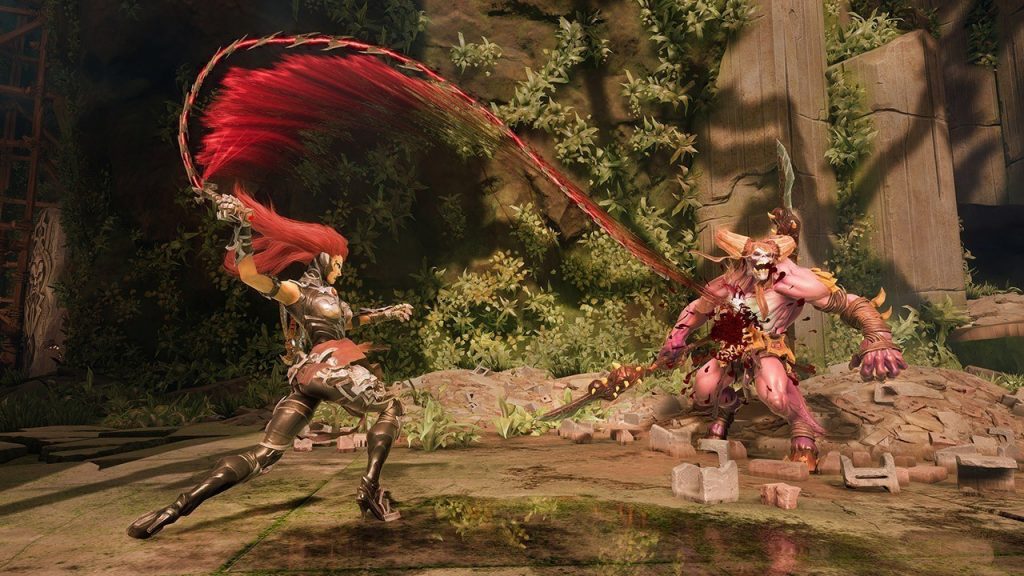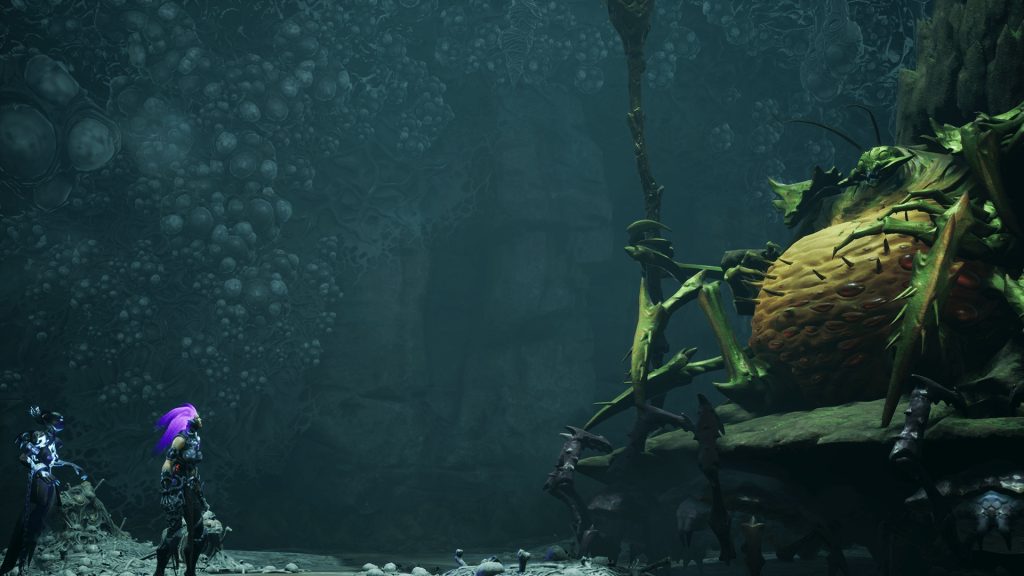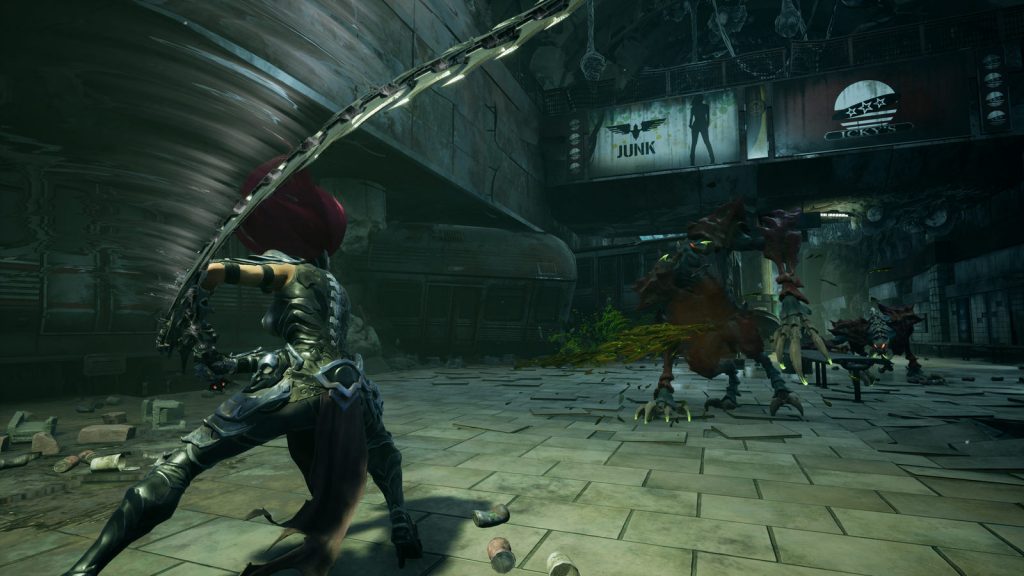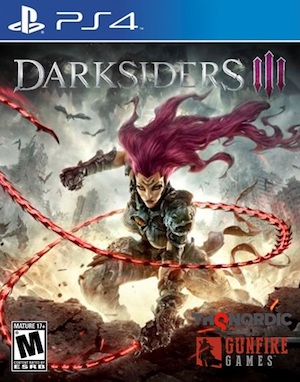
The original Darksiders ended with a hell of a cliffhanger, showing the Four Horsemen – in this case War, Death, Fury, and Strife because really, who wants to play as Famine or Pestilence? – reunited and on their way to do battle with… well, I won’t spoil it for those who haven’t played it, but let’s just say it’s exciting. Unfortunately, it’s a premise that the sequels seem hellbent on ignoring. The first game follows War, who is wrongfully accused of starting the apocalypse ahead of schedule – which results in humanity’s extinction – as he sets out to set things right. The second game is about Death, but it’s a prequel that focuses on his fight to prove his brother’s innocence and restore humanity. The third game, which stars Fury, the only female Horseman, is also a prequel. See, the apocalypse has unleashed the Seven Deadly Sins, and it’s Fury’s job to hunt them down.
Vigil Games, the studio behind the first two games, may be gone, but the newcomers at Gunfire Games, which features a large chunk of Vigil’s staff, carries the torch admirably here. Darksiders is unique in that each game is very different from the one that came before it. In fact, they often operate in different genres based on the Horseman you’re playing. War was a brick that waded into combat and destroyed things. Combine that with the ruined state of the post-apocalyptic environments he was exploring, and it made sense that the original game was a mash-up of Zelda and God of War. You’d explore dungeons linked by a hub world as you would in a Zelda game, getting new items that would aid your ability to traverse the world and its dungeons at key points in the plot, while carving up enemies like Kratos.
Death was more refined and his game reflected that. Anything is a weapon in his hands, so the game was more of an action RPG, allowing you to find new weapons and gear and level up and customize his abilities. It was also significantly larger, focusing more on a vast world than the tightly constructed environments and dungeons of the original, though both were still present. Yes, you still had a horse to ride and the hub and spoke structure of the world meant that things felt similar, but there was a greater focus on customization, questing, and character interaction that simply wasn’t present in War’s adventure.
"Dying spawns you at the last Serpent Hole you interacted with, which serve both as Vulgrim’s store and the game’s fast travel system, and also respawns all the enemies on the map. You want your souls back? You’ll have to fight for them. Want a better weapon? You’ll have to find the right items in the world and take them to Ulthane, the Maker – Darksiders’ version of a forge god – and have him upgrade what you have. "
Fury’s, however, is another matter entirely. It’s operating in a different genre, but the best comparison is one I’m loathe to make because of how overused it is within the gaming press. That’s right: it’s like Demons’ Souls. Well, more like if Demons’ Souls had a sequel or three that were focused on navigating one fluid environment based around a series of checkpoints instead of standalone levels that sent you back to the beginning every time you died. If it were, say, a darker game. But it’s not like those games because it’s hard, although it is easily the most difficult Darksiders game, or because of some arbitrary similarity that makes it an easy cultural touchstone that also has the benefit of getting clicks when you write “Darksiders III is like [Insert Hypthetical Sequel to Demons’ Souls here].” No, it’s like them because Darksiders III shares their structure and many of their core mechanics.
I’ll explain. Like the aforementioned games that don’t exist and would not be named if they did, Darksiders III takes place in a giant, interconnected world. Gunfire has described it as one big dungeon, and after playing it, I understand why. As you move through the different environments, each of which is visually distinct, you’ll cut down whatever set of enemies inhabit it. Doing so will reward you with souls, which serve as both the game’s currency and experience system. You can feed them to Vulgrim, Darksiders’ erstwhile merchant demon, and gain levels, which can then be spent on any of Fury’s three stats: Health, Strength, or Arcane, or use them to buy items. The more souls you get, the better stuff you can afford. The catch is that if you die, and you will, you lose all your souls until you walk back to where you last died and reclaim them. Dying spawns you at the last Serpent Hole you interacted with, which serve both as Vulgrim’s store and the game’s fast travel system, and also respawns all the enemies on the map. You want your souls back? You’ll have to fight for them. Want a better weapon? You’ll have to find the right items in the world and take them to Ulthane, the Maker – Darksiders’ version of a forge god – and have him upgrade what you have. Sound familiar?
In addition to these new systems, it’s also worth noting what this game doesn’t have: there’s no loot to acquire, no mini-map to help you when you’re lost or guide you to the next item, no horse to ride, and very little inventory to manage. There aren’t even any chests to open. Items – usually either Soul Lurchers, which give souls when consumed, health items, other consumables, or upgrades – appear as small balls of fire on the ground, often near dead bodies. Even the use of recovery items has changed. Fury is equipped with a limited number of recovery items called Nephilim’s Respite that restore large chunks of her health. There are other items you can buy and find called Health Shards, but these have cooldowns and often don’t restore as much health. You gain all of your available charges of Nephilim’s Respite back when you die and you can permanently upgrade your charges should you find the required items in the wild, but their numbers are limited, meaning you have to manage them appropriately as you make your way to the next Serpent Hole.
"If War was a sledgehammer and Death was a scalpel, Fury is brutal, merciless rage. She positively flies around the screen, dispatching enemies quickly, efficiently, and with a level of contempt for her adversaries that neither War nor Death exhibited. She starts with a whip, which is her primary weapon, but gains access to other weapons, known as Hollows, over the course of her journey."
If it all sounds remarkably like The Game That Shall Not Be Named, it is, but there are also subtle differences. First, you can only restore charges of Nephilim’s Respite by killing enemies, all of whom have a chance to drop another charge, or by dying. That’s it. Getting to a Serpent Hole isn’t good enough. Using a Serpent Hole also doesn’t respawn all of the enemies you’ve just killed; they only respawn when you die, so there’s not really a way to grind souls short of dying over and over again. It also makes each death more painful, as it means you have to fight everything in the environment again, no matter when or how long ago you killed them, should you encounter them. Dying multiple times also doesn’t erase the souls you’ve lost. I’ve died multiple times while trying to get back to a particular area, only to find each set of souls waiting for me. Some did disappear, but this only happened when I had died a significant number of times trying to get back to them. Your pause menu also functions as an actual pause menu, not just a menu to navigate.
Darksiders III manages to balance all of these new mechanics while feeling unabashedly like a Darksiders game and a perfect vehicle for Fury as a character. If War was a sledgehammer and Death was a scalpel, Fury is brutal, merciless rage. She positively flies around the screen, dispatching enemies quickly, efficiently, and with a level of contempt for her adversaries that neither War nor Death exhibited. She starts with a whip, which is her primary weapon, but gains access to other weapons, known as Hollows, over the course of her journey. The Flame Hollow gives her a pair of Kratos-esque chains, which are fast and do good damage, while the Storm Hollow provides a slower, more damaging spear. There are two more Hollows as well, but I don’t want to spoil them. Fury’s whip is always equipped and bound to one attack button, while the Hollow you use at any given time – you can switch them out at will – is bound to another.
This control scheme means that each weapon only has about three combo chains based on normal inputs, delaying an input at a certain time, or holding the button down, with a few other attacks that are activated with Fury’s dodge. Individually, the weapons aren’t that exciting, but you can chain any individual move into any other, meaning you can combine any combo for any one weapon with any other combo for that weapon, or the other weapon you have equipped, at any given point in that combo. For instance, it’s possible to start Fury’s standard whip combo, chain it into her delayed whip combo about halfway in, and finish it off by going straight into a combo with whatever Hollow you have equipped. If that doesn’t work, you can just cancel that Hollow combo back into a whip attack. Darksiders III’s combat is simple, yes, but the level of freedom suits Fury as a character – she is a haughty, arrogant, angry lady – and allows for a lot of interesting possibilities.
"ury doesn’t have the ability to guard, so using her dodge correctly is paramount. Time her dodge right, and you’ll be able to unleash a counter-attack that does massive damage. It’s high risk, since even basic enemies do a lot of damage, but Fury is at her best when she’s dancing around enemies and unleashing devastating follow-ups."
In addition to her standard weapons, Fury also has access to Wrath Attacks, devastating area of effect skills that can be used whenever she fills up her Wrath Meter by attacking or using specific items. These attacks depend on which, if any, of the Hollows you’re using. Her standard Wrath Attack is a simple area of effect attack with her whip, but activating it while using the Fire Hollow causes Fury to catch fire, boosting her attacks and damaging enemies that get too close. Using it with the Storm Hollow, on the other hand, summons a series of tornadoes that lock enemies in place for easy, high damage combos.
The cherry on top of all of this is Havoc Form. After filling her Havoc Meter with either an item or her attacks, Fury can transform into Havoc Form, a monstrous purple beast that unleashes utterly devastating attacks and restores Fury’s health. Havoc Form doesn’t last long, but it does incredible amounts of damage, even against bosses, and you can cancel it at any time to preserve your meter.
All of these options, combined with the leveling system and weapon enhancements, allow you to build Fury’s playstyle to suit what you want to do. If you want damage, level Strength, which increases damage from standard attacks. If you want to have hard-hitting counter-attacks, level Arcane, which also boosts Fury’s Wrath Attacks and Havoc Form. Want a beefier Fury? Invest in Health. Of the three, my favorite was Arcane, simply because you spend so much time in Darksiders III dodging. Fury doesn’t have the ability to guard, so using her dodge correctly is paramount. Time her dodge right, and you’ll be able to unleash a counter-attack that does massive damage. It’s high risk, since even basic enemies do a lot of damage, but Fury is at her best when she’s dancing around enemies and unleashing devastating follow-ups.
" Unlike her brothers, Fury can’t run along walls and doesn’t do a lot of climbing. She’s more dependent on using her tools to get around, whether it’s using her whip to grapple between areas or the abilities bestowed on her by one of her Hollows."
Weapon enhancements offer more customization, allowing you to tune each individual weapon to your needs. Enhancements start with two traits, and can be pushed toward either an angelic or demonic alignment, which favors one of the two, at least initially. You upgrade them by finding items in the world and having Ulthane forge the path you want. Even better, you can socket them into any weapon at will, so you’re not limited to your first choice. How you upgrade them has important effects, from giving you more Soul Lurchers to offering lifesteal, and everything in-between.
All that said, Darksiders III isn’t just about combat. Navigating the world is important, too. The different parts of the map feel distinct, and each is populated with its own enemy type. Unlike her brothers, Fury can’t run along walls and doesn’t do a lot of climbing. She’s more dependent on using her tools to get around, whether it’s using her whip to grapple between areas or the abilities bestowed on her by one of her Hollows. The Fire Hollow, for example, allows her to cross lava without taking damage or jump to higher places, while the Storm Hollow lets her glide between areas and float through updrafts. This, combined with the detailed world, makes the game a joy to explore, because you’re always finding new things or using a new ability to access a previously unavailable part of an old area. This exploration is fun and often rewarding, and does a lot to aid the game’s pacing.
In the end, almost every aspect of Darksiders III comes together. The story and characters are fun, the combat, especially during the game’s excellent and varied boss fights, is engaging and allows you to play how you want to, and the world is fun to explore. The game also features gorgeous art design that maintains the style of the original games, even without the input of legendary comic artist Joe Madureira. Even with a different studio and publisher, this still feels like a Darksiders game, albeit one that is much different than its predecessors.
"It’s a departure from the earlier games in the series, yes, but it knows what it wants to do and does it well, melding genres and design philosophies to create something familiar, and yet wholly its own."
It’s flawed, of course. Things take a little while to get going, especially because you spend the first few hours stuck with nothing by Fury’s whip, which doesn’t really work given the game’s combat system. Navigating areas can also be a bit frustrating. Fury has a directional compass that guides her to the Seven Deadly Sins, but it can be a bit hard to follow given that there are, you know, quite a few of them. The game could also stand to be more specific about what exactly will permanently lose you souls.
Like many of these kinds of games, there are difficulty spikes that can feel annoying and unfair, especially given that Fury can’t block and many of the enemies have lunging attacks that are faster than she is. This makes dodging away from them to heal, or running to avoid a fight, almost impossible in certain situations, especially if the game decides to throw a large group of enemies (think 10 or more) at you in a small space. It’s an infrequent occurrence, to be sure, and you can get through it, but it’s still an annoyance that simply isn’t fun, especially if you’re trekking back to your souls. And as enjoyable as the story is, it’s still sad to see another prequel in a series where, nearly a decade later, we’re still waiting to see what happens next.
Still, none of these problems are insurmountable and they pale in comparison to what the game does right. Fury’s a fun character, as are the people she interacts with, and her game – and the way she plays – suits her in a way most action games never manage to get right. I didn’t expect to enjoy Darksiders III as much as I did, and I certainly didn’t expect it to be this good. It’s a departure from the earlier games in the series, yes, but it knows what it wants to do and does it well, melding genres and design philosophies to create something familiar, and yet wholly its own. I still want to know what happens to the Horsemen after the events of the original, but Fury’s story is enough for now. In the meantime, we’ll just have to see the genre of game Strife rides in on.
This game was reviewed on the PC.
Gorgeous art style. New and old elements work well together. Lots of ways to level and customize Fury. A fun world to explore. Enjoyable story and characters.
Difficulty spikes can be irritating. The first couple of hours are slow. Hard to know when dying will cost you souls. It's still a prequel.









